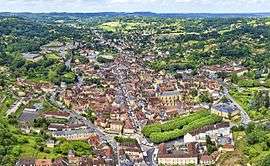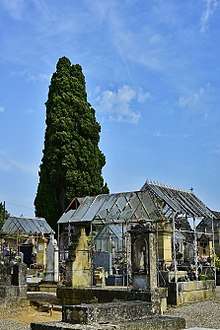Sarlat-la-Canéda
Sarlat-la-Canéda (French: [saʁ.la.la.ka.ne.da] ; Occitan: Sarlat e La Canedat), or simply Sarlat, is a commune in the Dordogne department in Nouvelle-Aquitaine in southwestern France. Sarlat and La Canéda were distinct towns until merged into one commune in 1965.[2]
Sarlat-la-Canéda | |
|---|---|
Subprefecture and commune | |
 An aerial view of Sarlat-la-Canéda | |
.svg.png) Coat of arms | |
Location of Sarlat-la-Canéda 
| |
 Sarlat-la-Canéda  Sarlat-la-Canéda | |
| Coordinates: 44°53′34″N 1°12′55″E | |
| Country | France |
| Region | Nouvelle-Aquitaine |
| Department | Dordogne |
| Arrondissement | Sarlat-la-Canéda |
| Canton | Sarlat-la-Canéda |
| Intercommunality | Sarladais |
| Government | |
| • Mayor (2008–2014) | Jean-Jacques de Peretti |
| Area 1 | 47.13 km2 (18.20 sq mi) |
| Population (2017-01-01)[1] | 8,869 |
| • Density | 190/km2 (490/sq mi) |
| Demonym(s) | Sarladais, Sarladaises |
| Time zone | UTC+01:00 (CET) |
| • Summer (DST) | UTC+02:00 (CEST) |
| INSEE/Postal code | 24520 /24200 |
| Elevation | 102–319 m (335–1,047 ft) (avg. 189 m or 620 ft) |
| Website | www.sarlat.fr |
| 1 French Land Register data, which excludes lakes, ponds, glaciers > 1 km2 (0.386 sq mi or 247 acres) and river estuaries. | |
Geography
The town of Sarlat is in a region known in France as the Périgord Noir (the Black Périgord, as opposed to the Green Périgord, the White Périgord, and the Purple Périgord).
History
Sarlat is a medieval town that developed around a large Benedictine abbey of Carolingian origin. The medieval Sarlat Cathedral is dedicated to Saint Sacerdos. This abbey appears in records as early as 1081 and was one of the few in the region that was not raided by the Vikings. The name for the abbey church was Saint Sacerdos by 1318; in the 20th century, it would become a cathedral under Pope John XXII.[3]
Because modern history has largely passed it by, Sarlat has remained preserved and one of the towns most representative of 14th century France. Its historic centre, with 77 protected monuments, was added to France's Tentative List for future nomination as a UNESCO World Heritage site in 2002.[4] The excellent state of preservation owed a debt to writer, resistance fighter and politician André Malraux, who, as Minister of Culture (1960–1969), restored the town and many other sites of historic significance throughout France. The centre of the old town consists of impeccably restored stone buildings and is largely car-free.[5][6]
Population
| Year | Pop. | ±% |
|---|---|---|
| 1968 | 8,801 | — |
| 1975 | 9,765 | +11.0% |
| 1982 | 9,670 | −1.0% |
| 1990 | 9,909 | +2.5% |
| 1999 | 9,751 | −1.6% |
| 2008 | 9,331 | −4.3% |
| 2016 | 8,946 | −4.1% |

 Portable still at Sarlat
Portable still at Sarlat House of De La Boétie, the immortal friend of Montaigne
House of De La Boétie, the immortal friend of Montaigne Centre of Sarlat on a summer's day
Centre of Sarlat on a summer's day
Economy
- Agriculture: Agriculture has long been of importance in the Dordogne area around Sarlat. Tobacco has been grown around Sarlat since 1857 and has historically been a major commodity for the area, although it is on the wane. Other agricultural commodities include corn, hay, walnuts, walnut oil, cheeses, wine, cèpes (a species of wild mushroom) and truffles.
- Tourism: Numerous visitors—especially from northern Europe (the United Kingdom, the Netherlands, Belgium, Germany, etc.)—come on holiday to Sarlat and the region surrounding it and some have settled there permanently. The months of July and August are traditionally the haute saison (high season) for visitors, as is true in much of France outside Paris.
- Foie gras: There are several large foie gras factories including Rougié, and many small producers of foie gras in the area;[6] other farms raise geese and ducks to produce products (confits, pâté, etc.) from these birds. The commune holds an annual three day festival, "Fest'oie", in honour of this significant part of its economy which also attracts numerous tourists.[7]
A film festival has been held in the commune every November since 1991. Other events include the Truffle Festival, Christmas Market and Fest’oie in winter, the Ringueta of traditional games, and the Theatre Games Festival.[8]
Transport
Sarlat railway station offers train services to Bergerac, Bordeaux and Périgueux.
The commune is also served by Brive Vallée de la Dordogne airport (50 km), Bergerac Roumanière airport (70 km) and two bus lines.[8][9]
Notable inhabitants

Sarlat was the birthplace of:
- Étienne de La Boétie (1530–1563), judge, writer, and philosopher, friend of Montaigne
- François Fournier-Sarlovèze (1773-1827), French general of the Napoleonic Wars
- Gauthier de Costes, seigneur de la Calprenède (c.1610-1663), novelist and dramatist
- Gabriel Tarde, judge and sociologist (1843–1904)
- André Malraux, a square and a gallery of paintings bear the name of the former Minister of Culture. This is explained by the fact that he is considered by many Sarladais as the saviour of the historical district of the city. While visiting Sarlat, he realised that the city was in danger of ruins in certain neighbourhoods and that some monuments were being destroyed. The Saved Areas Act was drafted to save the city.
- Jean-Jacques de Peretti, mayor of the city since 1989.
Cultural references
The town and region have featured in two major Hollywood films: Ridley Scott's The Duellists (1978) based on Joseph Conrad's Napoleonic tale; and more recently Timeline (2003) adapted from Michael Crichton's time-travel novel, set in 14th century France.
In the cemetery of Sarlat one can admire the pyramid or rests François Fournier-Sarlovèze
Other movies partly shot in Sarlat include:
- Ever After: a Cinderella Story (1998) by Andy Tennant
- The Musketeer (2001) by Peter Hyams
- Jacquou le Croquant (2007) by Laurent Boutonnat
- Jeanne d’Arc, by Luc Besson
The city also appears in the first instalments of French author Robert Merle's saga Fortune de France, which tells the story of a fictitious Huguenot, Pierre de Siorac, during the 16th and 17th century in France.
See also
- Communes of the Dordogne département
References
- "Populations légales 2017". INSEE. Retrieved 6 January 2020.
- Sarlat History French Moments Ltd
- Sarlat History
- Centre ancien de Sarlat
- SARLAT-LA-CANÉDA DEPARTMENT: DORDOGNE REGION NOUVELLE-AQUITAINE
- Contested Tastes: Foie Gras and the Politics of Food page 91
- Foie Gras Behind the Scenes of a French Delicacy
- Visit Sarlat la Canéda
- Fodor's Dordogne & the Best of Southwest France: with Paris
External links
| Wikimedia Commons has media related to Sarlat-la-Canéda. |